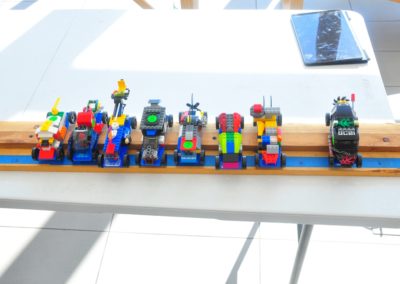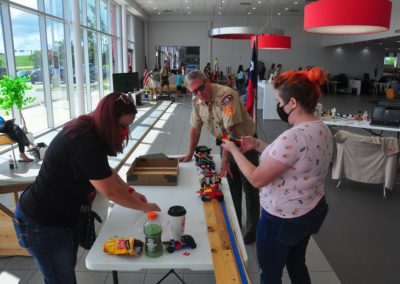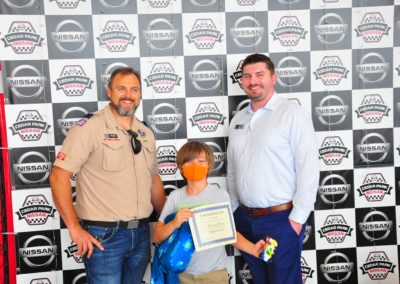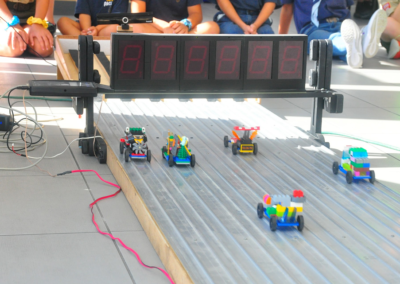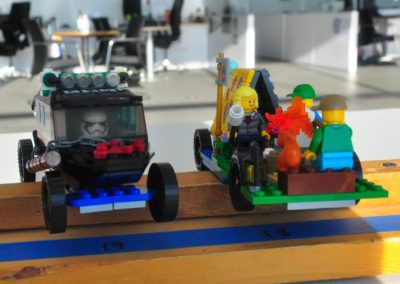Lego Derby! Did you even know there was such a thing? Well, there is and Pack 170 did it as both a Summertime Pack event and as a recruiting opportunity. Our Scouts had a great time, we made new friends in the community, and shared the principles of Scouting with families in Leander and Cedar park.
Our warmest thanks go to Cedar Park Nissan for hosting the Pack 170 Lego Derby. They cleared vehicles from their showroom floor to accommodate us, they provided last minute support including printing services, and General Manager Dustin Krieger even took time throughout the day to present awards to the winners as each race completed. It is great to find friends amongst our community’s businesses who support Scouting.
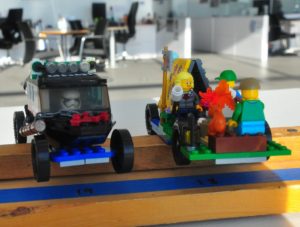
A Lego Derby is a lot like a Pinewood Derby except for the cars and it is that difference that makes it a great fit for a community Scouting event. Pinewood Derby is famous in American culture even with people that were never Scouts. It is the premier event of Cub Scouting and it has broad appeal with boys and girls as well as adults. It takes time, several days, to build a pinewood racer though, and tools, and paint, and… the list goes on… but a Lego racer can be built in less than an hour making a Lego Derby a one day event for participants.
STEM FACT
Drop a pencil and a soccer ball from the same height at the same time and they will hit the ground at the same time. The reason is that both objects are being pulled towards the earth by the same force, gravity. So, why don’t derby cars all finish at the same time?
Notice I said “… a one day event for participants“. Like any event, especially a derby, success comes with planning, preparation, and effort and that takes more than a day.
We started planning months in advance. A Google search showed there was broad support for Lego Derbies including videos, parts, rules, and more. Chasses and wheels (you the right Lego wheels for a Pinewood track) were not too expensive and could be ordered online, Zinc Lego bricks for weight too. We chose PinewoodPro for their prices and their shipping options. We stayed local for bulk Lego parts at “Bricks and Minifigs” near Lakeline Mall. We built Lego toppers on top of trophy bases we got from Crown Trophy and printed our own certificates with foil seals that we got on Amazon.
STEM FACT
Gravity isn’t the only force at play in a derby race. We also see Friction and Drag work against the car, as it goes down hill, and enters the long flat lane before the finish line. The key to a winning the race is knowing the TWO BEST WAYS to overcome these opposing forces.
The chassis was about $7.00 and another $4.00 for 2 Zinc bricks per racer. Add to that a share of the bulk costs for 40 lbs. of Lego bricks and adornments, trophy bases, certificates, bottled water, and chips. We settled on an entry fee of $25. In retrospect, we could probably have reduced that down to $20 per racer and perhaps attracted more potential Scouts. For this first Lego Derby, however, we wanted to keep the crowd to a manageable size, It is better to have a small success than a huge failure.
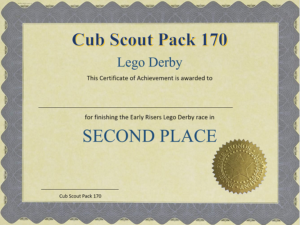

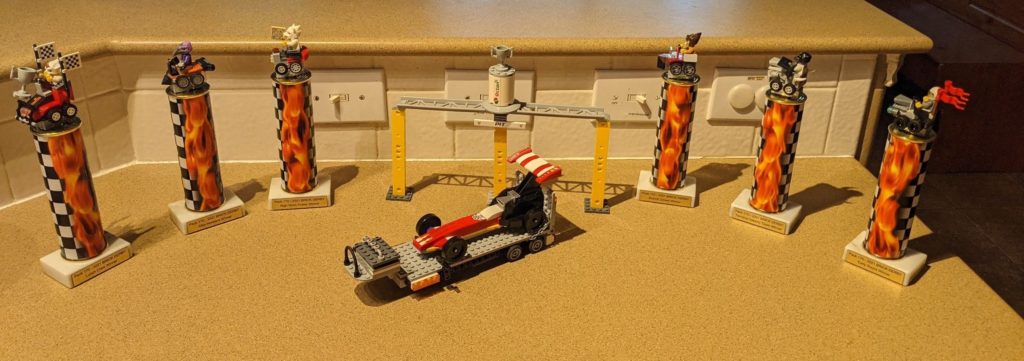
The setup started the night before. Track & timer, checkin station, welcome & recruiting table, and software configuration. Everything you would do for Pinewood Derby with one extra thing… a Lego racer build area. With several leaders present, we made quick work of it. The next morning we were in an hour ahead of our publicized start time of 8:00 AM to do the final setup. It was a good thing we came in early because some of our participants couldn’t wait to get started.
STEM FACT
Mass – the more massive an object, the better it can overcome drag and friction. That means the car can achieve a higher velocity (speed) while traveling down hill, which will carry it over the finish line. So, a winning derby car should be at or near the max allowable weight for competition.
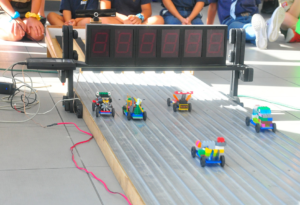
It took a little over an hour to get 6 cars built, checked, and registered so our first race started around 9:30 AM (30 minutes late), but the pace picked up from there, so we actually finished all 5 races we did that day, with 6 heats for each race, about an hour early. The best average times over the 6 heats of a given race received the awards. First place was a trophy and a certificate was awarded for second and third places. Only Scouts or Scout-aged kids were eligible for awards. All participants took their cars home with them, of course. There were smiles all around, even from the kids that didn’t win an award.
Here are a few more pictures from our Lego Derby that help to tell the tale. You may spot our new District Executive, Doug Cooper, in there amongst the cars and kids. He paid us a visit and talked with our Scouters, Scouts, and visitors. Thanks, Doug, for being there. Overall, it was a GREAT summertime pack event and a GREAT way to connect with the community, both with participants and our hosts. The event generated 5 leads for our pack and gave our Scouts an opportunity to earn the recruiter strip. This is something that we will definitely repeat, maybe even expanding the scope. If you want to know more, contact communications at northshoredistrict.org.
STEM FACT
The fastest speed a car reaches in a race is called its MAXIMUM VELOCITY. The maximum velocity depends on the distance the car falls (up and down). The higher the mass is, the longer gravity acts on the car during the slope. The result is more speed going into the flat lanes. So, the majority of weight should be near its back tires, since that is at the highest point on the track at the start of the race.




